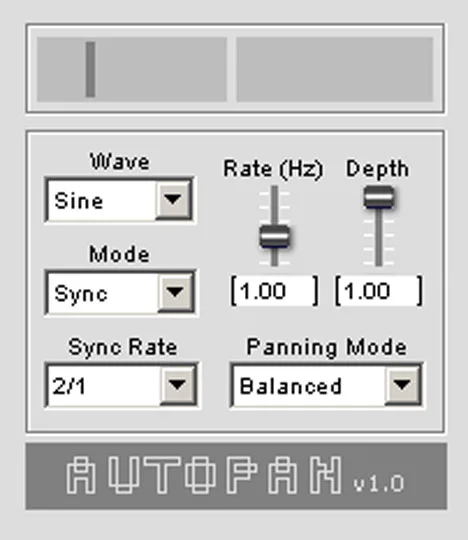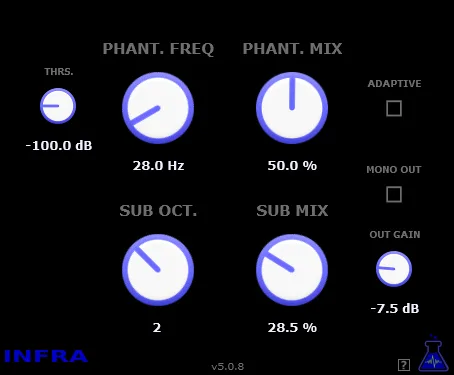In the world of sound, where each instrument strives to find its place, the stereo space plays a key role. Adding movement and dynamics can significantly enrich the sound, making the mix more alive and voluminous. This is where the autopanner comes to the rescue – an effect that can transform a regular static sound into a dynamic panorama that smoothly or rhythmically moves between the left and right channels, creating a captivating stereo effect.
Introducing the Autopan plugin from developer Oli Larkin – a simple but extremely effective tool for automatic panning. Forget about tedious manual pan automation, Autopan does it for you quickly and creatively, allowing you to easily add life and movement to your tracks. It’s an ideal choice for musicians, sound designers, and sound engineers who value ease of use combined with functionality that truly works.
What is Autopan and why do you need it?
At the heart of Autopan lies the principle of automatically changing the sound’s position in the stereo space using a low-frequency generator (LFO – Low Frequency Oscillator). Instead of the sound remaining fixed in the center, left, or right, Autopan forces it to “travel” between channels at a speed and shape that you can fully control. This creates a sense of movement, space, and depth, which can significantly enrich your sound and attract the listener’s attention.
The interface of the Autopan plugin from Oli Larkin is distinguished by its maximum simplicity and intuitiveness. The absence of unnecessary controls makes it accessible and understandable from the very first seconds of use, allowing you to quickly master it and immediately start creating.
Key Features and Capabilities
Despite its “basic” nature, as stated in the description, Autopan offers several important functions that make it a useful tool in your VST effects arsenal:
- Various LFO shapes: This is the heart of any modulation effect. Autopan gives access to different wave shapes (such as sine, triangle, sawtooth, square), which determine how the panorama will change. The sine wave will create smooth, “breathing” movement, while the square wave will create sharp, “chopped” transitions. Experimenting with different LFO shapes opens up wide possibilities for creating unique rhythmic and textural effects.
- Panning modes: The plugin offers different modes for applying the effect, which affect how the sound is distributed in the stereo space. This may involve processing a mono signal, preserving the stereo width of the original signal during panning, or other specific settings that give you precise control over the result.
- Synchronization with tempo: Like most modern modulation effects, Autopan has the ability to synchronize with the tempo of your project in the DAW. This allows you to create rhythmic panorama effects that fit perfectly into the groove of the composition, which is extremely important for electronic, dance, and any music where rhythm is the basis.
- Simple and clear interface: A clear design with a minimum number of controls (LFO speed, effect depth, shape/mode selection) allows you to quickly set up the desired effect without unnecessary complexities.
How to use Autopan in your tracks?
Autopan is a universal effect and can find its application in many musical genres and scenarios, from subtle livening up to extreme sound experiments:
- On pads and atmospheric synthesizers to add subtle or pronounced “horizontal” movement that fills the stereo space and makes them more voluminous.
- On clean or slightly overdriven guitars (especially on arpeggios or long-sounding chords) to create pulsating rhythmic effects that add dynamics.
- On backing vocals or individual effects to create interesting spatial movement that distinguishes them in the mix.
- To create captivating sound effects and transitions between parts of a composition, using fast or unusual panning.
- In experimental music, ambient or IDM Autopan can become a tool for forming constantly changing, unpredictable soundscapes.
It is important to remember to check the mono compatibility of your mix after applying any panning effect to avoid unwanted phase problems that may occur when listening on mono systems.
Conclusion
Autopan by Oli Larkin is a great example of how a simple and free tool can be extremely useful and creative in the studio. It makes automatic panning accessible and easy, allowing you to quickly add movement, depth, and interest to your music projects. It’s a reliable VST plugin for Windows operating system users (Win32) that’s worth having in your arsenal.
If you are looking for an effective way to liven up your sounds, add space and dynamics without unnecessary complexity, Autopan is exactly what you need. Download it today and see for yourself how easy and interesting it is to work with automatic panning. Give your sounds a new life and movement!



